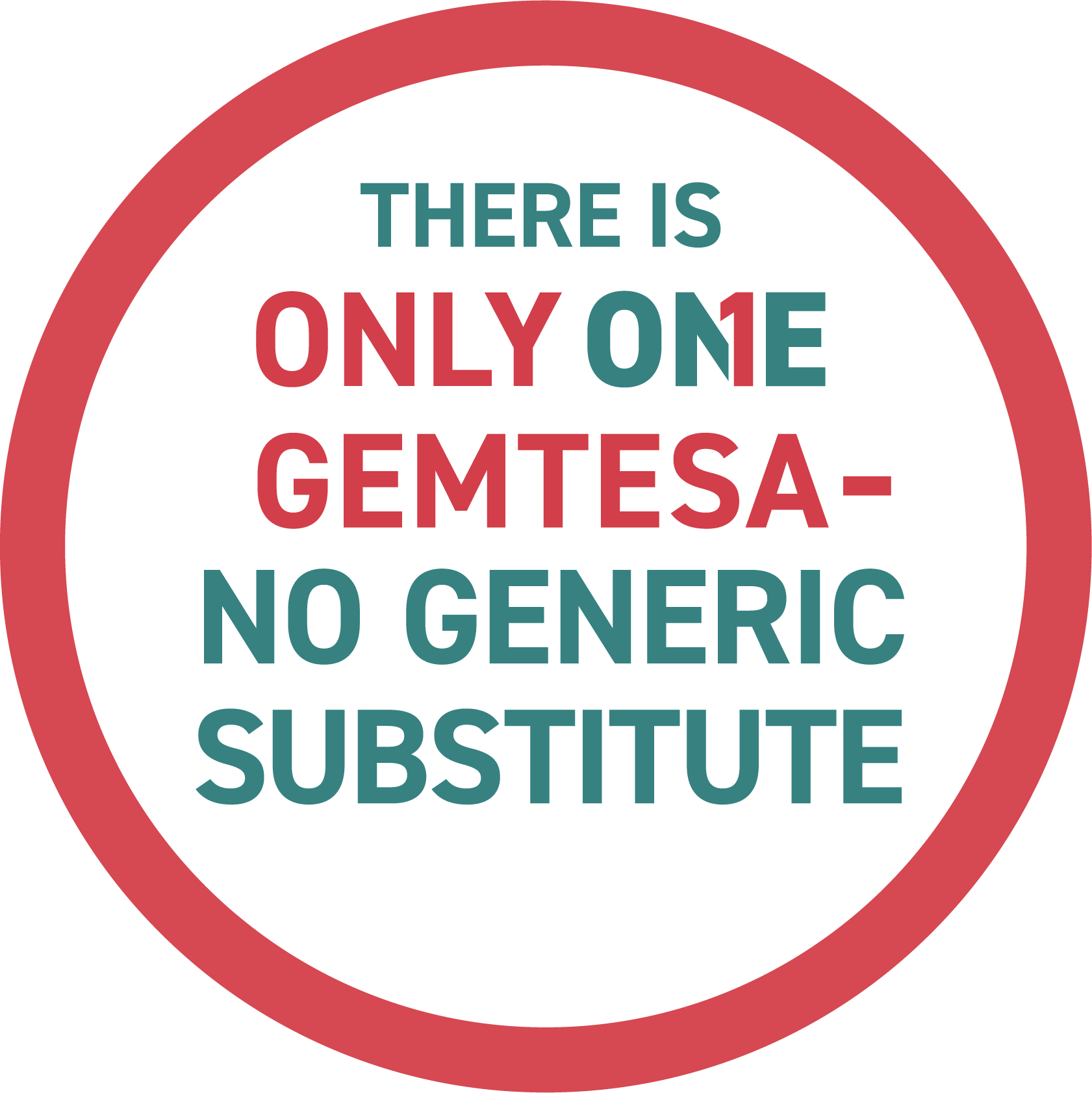FOR YOUR PATIENTS WITH
OVERACTIVE BLADDER (OAB)
MORE TIME HERE LESS TIME THERE
GEMTESA® (vibegron) is a beta-3 adrenergic agonist indicated for the treatment of overactive bladder (OAB) with symptoms of urge urinary incontinence, urgency, and urinary frequency in adults.



There's more to know about GEMTESA, a beta-3 agonist
Where would you like to go?
Prescribe GEMTESA 1st for OAB symptom relief
Proven
efficacy data
- Statistically significant reduction of all 3 key OAB symptoms† vs placebo at 12 weeks—including urgency1,2‡
- First and only beta-3 agonist with proven urgency reduction data in its label1,2
First and only
beta-3 agonist with
one dose, no titration
- Once-daily 75-mg dose with no titration, to be taken with or without food and swallowed whole with a glass of water1
- Crushability. In adults, GEMTESA tablets may be crushed, mixed with a tablespoon (~15 mL) of applesauce and taken immediately with a glass of water1
First and only
beta-3 agonist with
no blood pressure
warning in its label1
- No association with clinically significant changes to hypertension or increased blood pressure vs placebo3§||
Additional efficacy data
- ~43% of all OAB patients taking GEMTESA had a 50% reduction in urgency episodes at Week 12 vs 38% with placebo4¶
- 52.4% of patients taking GEMTESA had a ≥75% reduction in urge urinary incontinence (UUI) episodes at Week 12 vs 36.8% with placebo4¶
- 100% reduction in UUI episodes was reported at 12 weeks (28.8% of patients taking GEMTESA vs 22.5% with placebo) and 52 weeks (40.8% of patients taking GEMTESA vs 34.2% with active control)4,5#
¶Data were based on unadjusted values for a supportive outcome measure that was a prespecified secondary endpoint in the pivotal EMPOWUR trial.4
#Data were based on a prespecified secondary efficacy endpoint analysis of patients with 100% reduction in UUI from baseline at Week 12 (n=403) and an exploratory endpoint analysis of patients with 100% reduction in UUI from baseline at Week 52 (n=143).4
†The 3 key symptoms of OAB are urgency, micturition frequency, and UUI/leakage.2
‡The efficacy of GEMTESA was evaluated in a pivotal 12-week, double-blind, randomized, placebo- and active-controlled trial in patients with OAB (UUI, urgency, and urinary frequency). For study entry, patients had to have symptoms of OAB for at least 3 months with an average of 8 or more micturitions per day and at least 1 UUI per day, or an average of 8 or more micturitions per day and an average of at least 3 urgency episodes per day. A total of 1515 patients received at least 1 daily dose of placebo (n=540), GEMTESA 75 mg (n=545), or an active-control treatment (n=430). The majority of patients were Caucasian (78%) and female (85%) with a mean age of 60 (range 18 to 93) years.1,4
§In a 12-week pivotal study, hypertension rates for OAB patients taking GEMTESA (n=545) were 1.7% vs 1.7% with placebo (n=540). Increased blood pressure (BP) rates were 0.7% with GEMTESA vs 0.9% with placebo.6
||In a 4-week, randomized, placebo-controlled, ambulatory BP study in OAB patients (n=200), GEMTESA 75 mg was not associated with clinically significant changes in BP. Mean age 59 years; 75% female. At baseline: 35% of subjects had preexisting hypertension; 29% were taking at least 1 concomitant antihypertensive medication.1
Clinically significant reductions in all 3 key OAB symptoms* vs placebo at 12 weeks1,2†:
Urge urinary
incontinence
episodes
Micturition
frequency
Urgency
episodes
*The 3 key symptoms of OAB are urgency, micturition frequency, and UUI/leakage.2
†The efficacy of GEMTESA was evaluated in a pivotal 12-week, double-blind, randomized, placebo- and active-controlled trial in patients with OAB (UUI, urgency, and urinary frequency). For study entry, patients had to have symptoms of OAB for at least 3 months with an average of 8 or more micturitions per day and at least 1 UUI per day, or an average of 8 or more micturitions per day and an average of at least 3 urgency episodes per day. A total of 1515 patients received at least 1 daily dose of placebo (n=540), GEMTESA 75 mg (n=545), or an active-control treatment (n=430). The majority of patients were Caucasian (78%) and female (85%) with a mean age of 60 (range 18 to 93) years.1






